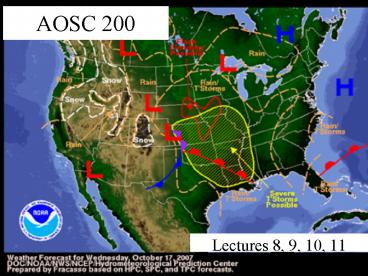AOSC 200 - PowerPoint PPT Presentation
1 / 15
Title:
AOSC 200
Description:
(1) collision-coalescence warm clouds. (2) Bergeron process cold clouds ... A body at rest tends to stay at rest while a body in motion tends to stay ... – PowerPoint PPT presentation
Number of Views:38
Avg rating:3.0/5.0
Title: AOSC 200
1
AOSC 200
- Lectures 8, 9, 10, 11
2
Precipitation
- Raindrops grow by two processes
- (1) collision-coalescence warm clouds.
- (2) Bergeron process cold clouds
3
(No Transcript)
4
Airflow Over a Mountain
5
How do we observe the atmosphere?
- Direct Methods
- Temperature
- Mercury thermometer, resistance thermometer
- Pressure
- Barometer mercury and aneroid
- Humidity
- Psychrometer (RH), dew point hygrometer
- Wind
- Anemometer (wind speed)
- Precipitation
- Rain Gauge
6
Satellite Observations
- Two principle orbits are used
- Sun-synchronous, aka polar orbiter, LEO (Low
Earth Orbit) 850 km. - Orbits in the sun-earth plane, crosses over the
poles. NOAA LEO cross the equator at 2.00 pm and
2.00 am each day. Each orbit takes about 90
minutes - Geosynchronous, GEO (Geostationary) orbits
around the earth always above the equator
36,000km. Orbital period is 24 hours, i.e. it
stays above the same point on the ground.
7
Doppler Effect
8
Newtons Laws
- First Law (Law of Inertia) A body at rest
tends to stay at rest while a body in motion
tends to stay in motion, traveling at a constant
speed and in a straight line, until acted upon by
an outside force - Second Law (Law of Momentum) A force exerted on
an object (including a parcel of water or gas) of
a given mass causes the object to accelerate in
the direction of the applied force and in
proportion to the force divided by the objects
mass. - Fma
9
Forces that Move the Air
- Gravitational Force
- Directed toward the center of the earth
- Approximately equal mass times g (9.8m/s)
- Pressure Gradient Force
- Always directed from High pressure to Low
- Expressed as a force per unit mass
10
CORIOLIS EFFECT
- WEATHER MAP SHOWS THAT WINDS GO AROUND A LOW
PRESSURE AREA, NOT ACROSS THE ISOBARS. - THIS DEVIATION IS A RESULT OF THE EARTH'S
ROTATION AND HAS BEEN NAMED THE CORIOLIS EFFECT
(CORIOLIS FORCE) - THIS FORCE ALWAYS ACTS AT RIGHT ANGLES TO THE
DIRECTION OF MOTION.
11
Centrifugal Force
Fig. 6.11
12
Geostrophic Flow
- Balance between Pressure Gradient Force and
Coriolis Force - Flow is at a constant velocity, parallel to
isobars - Usually applies to winds aloft where friction is
negligable
13
Fig. 6-15, p. 172
14
Surface Winds
- Balance between Pressure Gradient Force, Coriolis
Force and Friction - Causes surface winds to cross isobars toward Low
pressure
15
Land/Sea Breeze
- Caused by different heating rates over land and
water - Daytime wind from the ocean onto the land
- Night wind from land out over ocean

















![FIN 200 Week 8 Quiz [4 Sets] PowerPoint PPT Presentation](https://s3.amazonaws.com/images.powershow.com/7603710.th0.jpg?_=20150507085)













